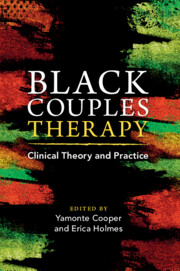Book contents
- Black Couples Therapy
- Black Couples Therapy
- Copyright page
- Contents
- Figures
- Tables
- Contributors
- Foreword
- Acknowledgments
- Introduction
- Part I Race, Racism, and Identity
- Chapter 1 Internalized Stereotypes and the Impact on Black Couples
- Chapter 2 The Role of the Strong Black Woman Schema in Black Love and Relationships
- Chapter 3 Black Same-Gender-Loving Male Couples’ Health within an Afrocentric Psychological Paradigm: The Influences of Spirituality and Religion
- Part II Foundations for Healthy Coupling
- Part III Adapting Major Therapeutic Approaches for Work with African American Couples
- Part IV Sex and Intimacy
- Part V Special Topics
- Index
- References
Chapter 3 - Black Same-Gender-Loving Male Couples’ Health within an Afrocentric Psychological Paradigm: The Influences of Spirituality and Religion
from Part I - Race, Racism, and Identity
Published online by Cambridge University Press: 27 July 2023
- Black Couples Therapy
- Black Couples Therapy
- Copyright page
- Contents
- Figures
- Tables
- Contributors
- Foreword
- Acknowledgments
- Introduction
- Part I Race, Racism, and Identity
- Chapter 1 Internalized Stereotypes and the Impact on Black Couples
- Chapter 2 The Role of the Strong Black Woman Schema in Black Love and Relationships
- Chapter 3 Black Same-Gender-Loving Male Couples’ Health within an Afrocentric Psychological Paradigm: The Influences of Spirituality and Religion
- Part II Foundations for Healthy Coupling
- Part III Adapting Major Therapeutic Approaches for Work with African American Couples
- Part IV Sex and Intimacy
- Part V Special Topics
- Index
- References
Summary
This chapter explores the ways in which religion, spirituality, and romance intersect in Black American same-gender-loving (SGL) men’s lives. Specifically, the author reviewed published scholarly literature on these topics. This review is followed by a critical analysis of the links between religion, spirituality, and romantic relationships and sexual experiences. This author explored the ways in which religion and spirituality influence the development, maintenance, dynamics, and quality of Black American SGL men’s romantic and sexual relationships. Then the author describes strategies, based on the reviewed literature and Afrocentric psychology theory, to help clinicians better assess the interplay of religion, spirituality, and romance. Clinical methods to treat sexual and psychological problems related to these factors are also explored. The chapter culminates with recommendations for future clinical research in this area.
Keywords
- Type
- Chapter
- Information
- Black Couples TherapyClinical Theory and Practice, pp. 58 - 82Publisher: Cambridge University PressPrint publication year: 2023



